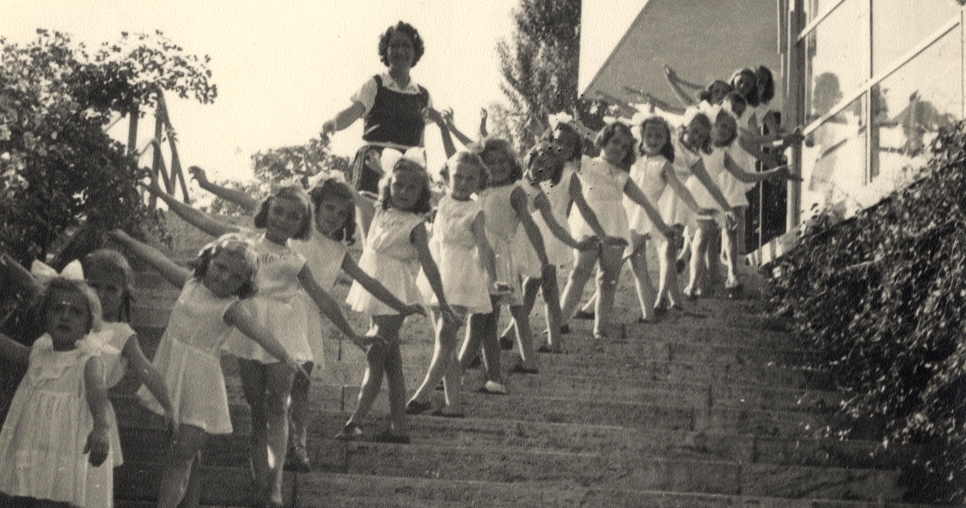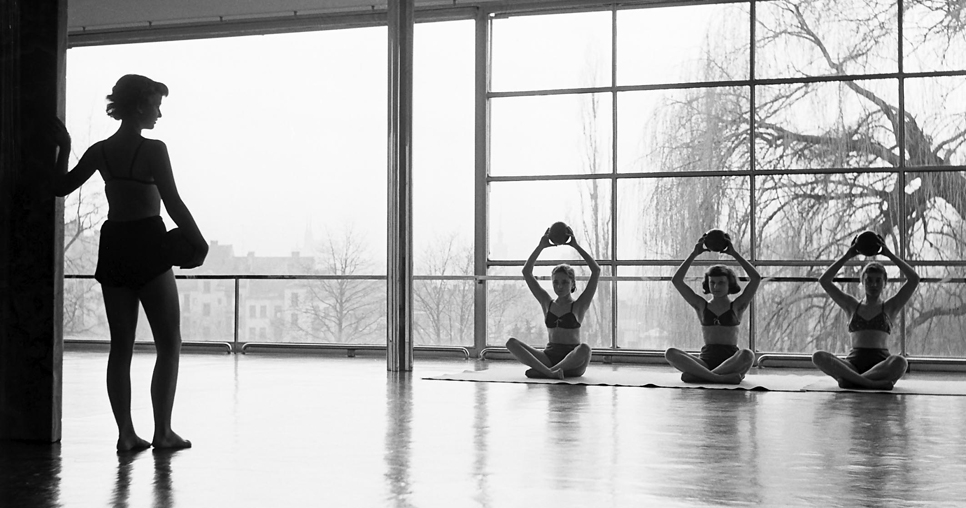Physical Education Institute of Karla Hladká, children exercising on the garden terrace, 1945 - 1950
The Tugendhats left Brno in May 1938. Thanks to their contacts in Germany they were well informed about the current developments wherein remaining in Brno would have amounted to a certain sentence of death for the entire family. Grete had been involved in activities for the League for Human Rights starting in the year 1933, after Adolf Hitler's rise to power, which provided financial and practical assistance for political refugees from Germany. Although the Tugendhats did not have all that rich social life, despite their home being an ideal setting, they did organise an annual bridge tournament in the Villa for up to one hundred invited guests. The proceeds from this event were consequently donated to the League for Human Rights. In May 1938, Grete and the children left for Sankt Gallen in Switzerland. Fritz remained in Brno with the governess Irene Kalkofen who helped him in preparing their personal things for transport along with certain pieces of furniture. Irene Kalkofen (1909-2004) came from Berlin and had both German nationality as well as citizenship. She had it seemed worked for the Tugendhats earlier in Germany and had consequently come to Brno from September 1928 up until 1929 and later from February 1931 practically from their moving into the Villa. She left Brno for England at the beginning of July 1938. In the year 1995 Mrs. Irene Kalkofen actually visited the Villa personally.
At the beginning of October 1939 the Villa was taken over by the Gestapo and from January 1942 became the property of Nazi Germany. In the autumn of the year 1940 the German soldier and architecture student, Louis Schoberth, stayed in the Villa. He became friends with Gustav Lössl, the Tugendhat's chauffeur who had remained in the house up until the beginning of September 1941. According to Schoberth's account, the half cylinder from Makassar ebony was no longer in the Villa nor the majority of the furnishings as of the autumn of the year 1940. Radical construction changes came about in the 1940s when Walter Messerschmidt, director of Klöcknerwerke in Brno, had his flat and office here. He had amongst other things the glazed milk glass wall bricked up at the street façade and the entrance way from the upper terrace. He also increased the height of the chimney and had additional inner walls inserted into the interiors.
The cavalry regiment of Marshal Malinovský contributed to the devastation of the house upon the occasion of the liberation by the Soviet Army in April 1945. Vlasta Hvozdecká recalls it as follows, “They tore down the garden fence of a length of approximately 6 metres and rode from here around Černá Pole where they plundered flats. Since we lived directly across from the destroyed fence of the Tugendhat garden, we were horrified by their behaviour. We could only see the former conservatory in the Villa from the window of our living room. They created a stable for their horses from the magnificent social rooms!” The remains of the furniture served as wood fuel while the linoleum on the floors was destroyed by the hoofs of the horses. The glazed walls were broken as a consequence of the pressure waves during the bombardment. The state of the Villa at the end of the war was described succinctly in a written protocol. For example on the terrace were “the damaged bench and (…) scattered pieces of furniture (…)”, the flat of the caretaker “had everything in a desolate state, devastated, broken, fragments, rubbish, dirt, rags, various garbage, glass, etc. all over the floor.” The main living area had “the large window panes smashed with glass everywhere along with horse manure as the entire Villa had been used for housing horses. Only the onyx wall remained along with the built-in bookshelf (…).” The utility floor “was missing the motors for the machines for air movement and for letting down the windows, the boiler had been damaged (…).” The removal of the damage was entrusted to the Brno architect Albín Hofírek. The broken window panes were temporarily glazed while the linoleum in the main living area was replaced with red wood wool cement board.
The private dancing school of an instructor at the Brno conservatory Karla Hladká consequently sat in the Villa from August 1945 up to June 1950. The structure was placed under the ownership of the Czechoslovak state in October 1950 and a rehabilitation centre for children with spine defects was established here as part of the nearby children’s hospital up to the end of the 1960s.



